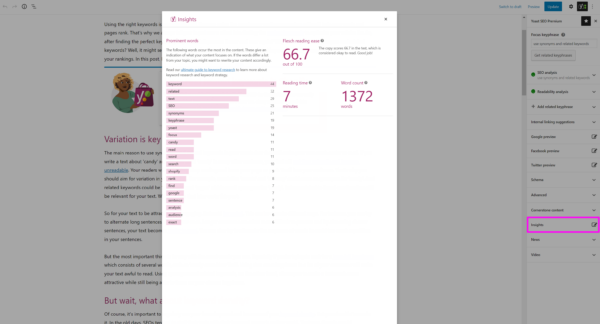The Flesch reading ease score: why and how to use it

If you use our readability analysis in the Yoast SEO plugin, you probably have seen the Flesch reading ease score. This score tells you how easy to read your text is. You might have wondered: how is the Flesch reading ease score calculated? Why is this score important for SEO? And, crucially, how can you use it to improve your writing? In this post, I’ll give you the answer to those questions.
Attention! We made some important changes to our readability analysis in Yoast SEO 19.3. We replaced the Flesch reading ease score with the new word complexity assessment. You can still find the Flesch reading ease score in the Insight tab, but we won’t use this assessment in our readability analysis anymore.
What is the Flesch reading ease score?
The Flesch reading ease test measures the readability of a text. It uses two variables to determine the readability score:
- the average length of your sentences (measured by the number of words)
- the average number of syllables per word
Then, it provides you with a score between 0 and 100. A score of 100 means your copy is very easy to read. A score of 0 means your text is very difficult to read. You can see the exact interpretation of all the scores on the scale in the table below.
| Score | Notes |
|---|---|
| 90-100 | very easy to read, easily understood by an average 11-year-old student |
| 80-90 | easy to read |
| 70-80 | fairly easy to read |
| 60-70 | easily understood by 13- to 15-year-old students |
| 50-60 | fairly difficult to read |
| 30-50 | difficult to read, best understood by college graduates |
| 0-30 | very difficult to read, best understood by university graduates |
So, a text with a very high Flesch reading ease score is made up of short sentences, and it contains many two-syllable words. Conversely, a text with a very low Flesch reading ease score consists mostly of long sentences and many complex words.
The Flesch reading ease score in Yoast SEO
You can find the Flesch reading ease score in the Insights tab in your sidebar. It looks at two aspects of your text:
- how the amount of words relates to the amount of sentences
- how the amount of syllables relates to the amount of words
A reading ease score of 60-70 is considered acceptable for web copy. Translated into simpler terms, that means that a 13-to 15-year-old student should easily understand a good web text.

Why is the Flesch reading ease score important for readability and SEO?
It’s essential to take readability into account when writing web copy. Why? Because if your text is too complicated, your audience might have trouble understanding it. Consequently, they may leave your website and look for information elsewhere. As a result, you might get a high bounce rate that can lead to lower rankings in the long run. That’s why you should aim to write as clearly as possible.
Writing easy-to-read texts is also in line with holistic SEO. As Google’s algorithm becomes more human-like and voice search rises, readable texts indirectly contribute to higher rankings.
While writing readable texts is important, it can also be tricky. This is because readability depends on a lot of factors. To help you write a copy that’s easy to read and understand, the readability section of the Yoast SEO content analysis runs all kinds of checks, among which was also the Flesch reading ease score.
Do you want to step up your SEO game? Then you should get Yoast SEO Premium! Its advanced text analysis helps you write naturally flowing texts, and the internal linking tool and the content filters make your posts easy to find. Also, 404 errors become a thing of the past with the redirect manager and the social previews giving you full control of how your posts appear on social media.
How to use the Flesch reading ease score to improve your writing
We’ve come to the essential question. How can you use the Flesch score to improve your writing? Well, you write for an audience and know your audience the best. Before writing or editing, consider what kind of texts fit your readers. Do you sell clothes or organize photography workshops? Or do you write for a mom blog or make step-by-step DIYs? Your content should be relatively easy to read in all these cases since you are targeting a broad audience.
However, remember that you do not have to chase a high Flesch reading score at all costs. For example, you may write about complex, specialist topics for a specific, more knowledgeable audience. Or, perhaps you are an academic blogging about your research? It makes sense if the Flesch test produces a lower score in those cases.
Still, whatever your situation is, your text always benefits from concise language. So, if you want to benefit from the feedback the Flesch reading ease score gives you, focus on two things:
1. Shorten your sentences
Too many long sentences make your text difficult to read, while short sentences keep the subject clear. When the sentences in your text are short, you allow your readers to absorb the information in your text. As a result, they don’t need to use all their attention to decipher what you want to say. That is why we advise you to break down long sentences; your text will be much easier to read.
And please, don’t think that by using short sentences, you will oversimplify your text. Let’s compare two short texts to show you what we mean. First, we have this sentence:
My favorite place to visit during weekends is my grandparents’ house near the lake, where we love to fish and swim, and we often take the boat out on the lake.
Did you find this sentence easy to read? Wasn’t it too lengthy, confusing, and difficult to process? Breaking it into two or more sentences can make it much clearer:
My favorite place to visit during weekends is my grandparents’ house. It’s near the lake, where we love to fish and swim. We also often take the boat out on the lake.
These few short sentences are much easier to read. Yet, you give the same information as in the long sentence, so there is no oversimplifying. Using short sentences keeps the subject clear and lets your readers absorb the information you’re presenting.
2. Limit your use of difficult words
Words with four or more syllables are considered difficult to read, so try to avoid them where possible. Or try to not to use them too much. For example, try words like small instead of minuscule, about instead of approximately, and use instead of utilize.
If you want to reach a broad audience, you should also try to avoid using jargon. If you’re a medical expert, you’re probably familiar with terms like analgesic, intravenous, and oophorectomy. However, keep in mind that most people aren’t. When you can’t find a better alternative, make sure to explain it for users who might not know the word.
Want to learn how to write great content that’s readable and SEO-proof simultaneously? Our SEO Copywriting course and other SEO courses can help you with that. You can access these courses with Yoast SEO Premium, which also gives you access to extra features in the Yoast SEO plugin.
Go Premium and get free access to our SEO courses!
Learn how to write great content for SEO and unlock lots of features with Yoast SEO Premium:
Final notes
We have to make a few notes regarding the Flesch reading ease score. First of all, language isn’t math. You cannot strip down the readability of a text to a simple formula. Keep in mind that readability depends on many factors, not just the length of your sentences and words.
Also, this test doesn’t consider your writing style or audience. We know there are industries where the language used differs from what most people would use. That’s perfectly fine. Try to use the score as a guideline and always use common sense when interpreting the Flesch readability ease score.
Read more: SEO copywriting: the Ultimate guide »


I think the Flesch score is a great indicator for readers in general.
But, as is the case on my site, I sometimes need to post articles under the category “Aviation Pros”. These are articles often requested by professionals within my industry, constituting 30% of my readership demographics.
Those articles, attractive to highly educated professionals within the field necessitates a lot of professional jargon, however!
Because of the very basic setup of the Flesch software, such articles using professional jargon are judged at a low score. Flesch isn’t “smart enough” to understand the kind of reader you address.
Thus, I only pay attention to that score when my individual article content is intended for readers not professionals of the aviation industry.
A short & Crisp enlightening piece from Yoast. Readability indeed has a profound impact on SEO. It simply makes sure that your content can be consumed by all sorts of the audience, not just from a specific flamboyant segment that is blessed with advanced vocabulary.
A short & Crisp enlightening piece from Yoast. Readability indeed has a profound impact on SEO. It simply makes sure that your content can be consumed by all sorts of the audience, not just from a specific flamboyant segment that is blessed with advanced vocabulary.
I’ll surely keep in consideration this important factor while writing the content. I have always saw the readability feature on the wordpress post and page, but never come across the Flesch reading score. However, your post has provided me important insights about Readability, Flesch Score, and most importantly, the importance of keeping the content short and straight-forward.